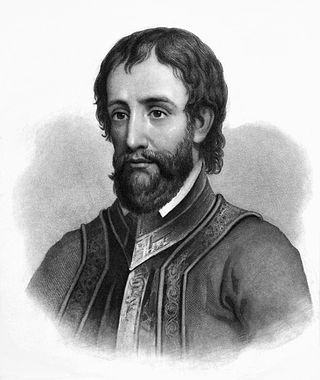
Hernando de Soto was a Spanish explorer and conquistador who was involved in expeditions in Nicaragua and the Yucatan Peninsula. He played an important role in Francisco Pizarro's conquest of the Inca Empire in Peru, but is best known for leading the first European expedition deep into the territory of the modern-day United States. He is the first European documented as having crossed the Mississippi River.

DeSoto County is a county located in the Florida Heartland region of the U.S. state of Florida. As of the 2020 census, the population was 33,976. Its county seat is Arcadia.
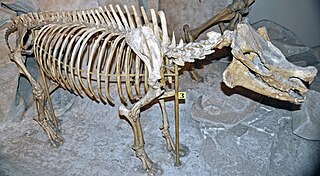
Menoceras is a genus of extinct, small rhinoceros endemic to most of southern North America and ranged as far south as Panama during the early Miocene epoch. It lived from around 30.7—19.7 Ma, existing for approximately 11 million years.

DeSoto Site Historic State Park is a Florida state park located in Tallahassee, Florida. It consists of 5 acres (20,000 m2) of land near Apalachee Parkway, including the residence of former Governor John W. Martin. The site is intended to initiate research and education on nearly four centuries of recorded history beginning with Hernando de Soto's use of the site as a winter encampment in 1539. There is an exhibit of items found at the site in the Governor Martin House.

Castoroides, or giant beaver, is an extinct genus of enormous, bear-sized beavers that lived in North America during the Pleistocene. Two species are currently recognized, C. dilophidus in the Southeastern US and C. ohioensis in the rest of its range. C. leiseyorum was previously described from the Irvingtonian of Florida, but is now regarded as an invalid name. All specimens previously described as C. leiseyorum are considered to belong to C. dilophidus.

The Pinellas Bayway System is a series of bridges on two state roads in Pinellas County, Florida. It is a toll road complex maintained and operated by the Florida Department of Transportation. It also is compatible with the SunPass ETC system currently in use on all other FDOT-owned toll roads. The Pinellas Bayway consists of:
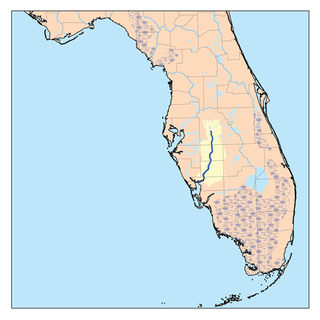
The Peace River is a river in the southwestern part of the Florida peninsula, in the U.S.A. It originates at the juncture of Saddle Creek and Peace Creek northeast of Bartow in Polk County and flows south through Fort Meade Hardee County to Arcadia in DeSoto County and then southwest into the Charlotte Harbor estuary at Punta Gorda in Charlotte County. It is 106 miles (171 km) long and has a drainage basin of 1,367 square miles (3,540 km2). U.S. Highway 17 runs near and somewhat parallel to the river for much of its course. The river was called Rio de la Paz on 16th century Spanish charts. It appeared as Peas Creek or Pease Creek on later maps. The Creek Indians call it Talakchopcohatchee, River of Long Peas. Other cities along the Peace River include Fort Meade, Wauchula and Zolfo Springs.

The Aucilla River rises in Brooks County, Georgia, USA, close to Thomasville, and passes through the Big Bend region of Florida, emptying into the Gulf of Mexico at Apalachee Bay. Some early maps called it the Ocilla River. It is 89 miles (143 km) long and has a drainage basin of 747 square miles (1,930 km2). Tributaries include the Little Aucilla and Wacissa Rivers. In Florida, the Aucilla River forms the eastern border of Jefferson County, separating it from Madison County on the northern part, and from Taylor County to the south.

Anhaica was the principal town of the Apalachee people, located in what is now Tallahassee, Florida. In the early period of Spanish colonization, it was the capital of the Apalachee Province. The site, now known as Martin Archaeological Site, was rediscovered in 1988.

Hesperocyon is an extinct genus of canids that was endemic to North America, ranging from southern Canada to Colorado. It appeared during the Uintan age, –Bridgerian age (NALMA) of the Mid-Eocene– 42.5 Ma to 31.0 Ma. (AEO). Hesperocyon existed for approximately 11.5 million years.
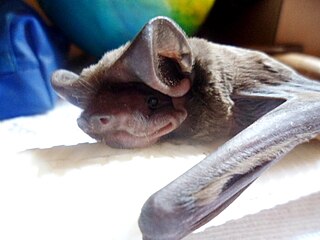
Wagner's bonneted bat or Wagner's mastiff bat, is a species of bat in the family Molossidae. It is found in the Americas from Argentina and Peru north to Mexico, and Cuba. Populations in Florida in the United States are now recognized as the Florida bonneted bat
The indigenous peoples of Florida lived in what is now known as Florida for more than 12,000 years before the time of first contact with Europeans. However, the indigenous Floridians living east of the Apalachicola River had largely died out by the early 18th century. Some Apalachees migrated to Louisiana, where their descendants now live; some were taken to Cuba and Mexico by the Spanish in the 18th century, and a few may have been absorbed into the Seminole and Miccosukee tribes.
Satherium is an extinct genus of otters that lived in North America during the Pliocene and Pleistocene. Two species are known, Satherium piscinarium and Satherium ingens.

The Gadsden County paleontological sites are assemblages of Early Miocene invertebrates and vertebrates occurring in Gadsden County, Florida, United States.
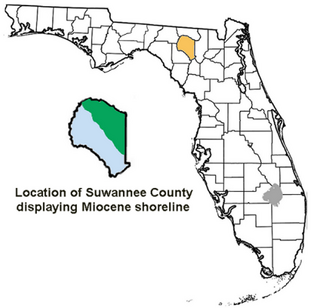
The Suwannee County, Florida paleontological sites are assemblages of Early Miocene invertebrates and vertebrates occurring in Suwannee County, Florida.
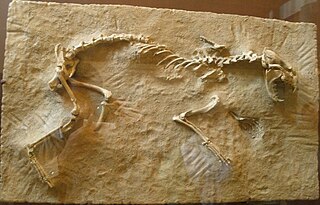
Sthenictis is an extinct genus in the weasel family (mustelids) endemic to North America and Asia during the Miocene epoch living from ~15.97—5.33 Ma (AEO) existing for approximately 11 million years.
Satherium piscinarium is an extinct species of giant otter of North America that lived during the Pliocene through Pleistocene from ~3.7–1.6 Ma. (AEO). existing for approximately 2.1 million years.
Trigonictis macrodon is an extinct species of mammal related to the living grison (genus Galictis). It lived in North America during the Pliocene to Pleistocene epochs, from ~4.1–1.6 Ma. (AEO), existing for approximately 2.5 million years. Fossil specimens have been found across the United States, from Washington and Oregon in the northwest to California and Florida in the south.

Enhydritherium terraenovae is an extinct marine otter endemic to North America that lived during the Miocene through Pliocene epochs from ~9.1–4.9 Ma. (AEO), existing for approximately 4.2 million years.
The De Soto Chronicles: The Expedition of Hernando de Soto to North America, 1539–1543 is a two volume book collection edited by Lawrence A. Clayton, Vernon James Knight, Jr., and Edward C. Moore, published in 1993 by The University of Alabama Press.















